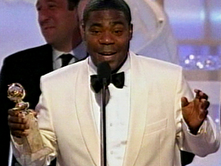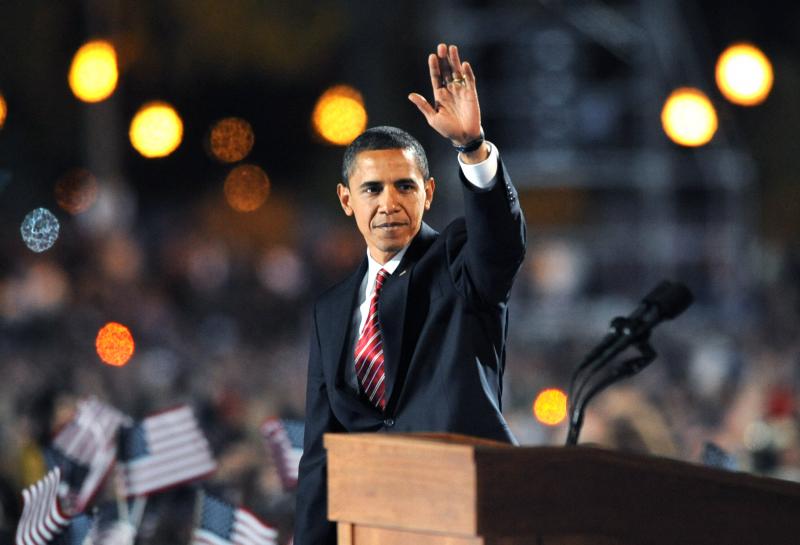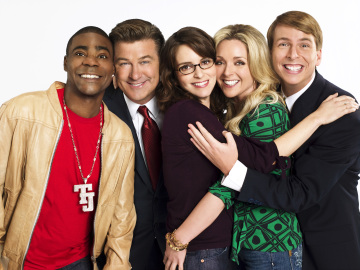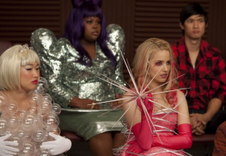What’s at stake in claims of “post-racial” media?
Mary Beltran / University of Wisconsin – Madison

Tracy Morgan, comedic actor best known for his role as comedic performer Tracy Jordan on the NBC series 30 Rock (2006+), trumpeted America’s supposed post-racial identity at the Golden Globe Awards in January 2009. When 30 Rock was awarded Best Musical or Comedy Television Series, he gleefully snatched the statuette from Tina Fey, creator and star of the series, quipping, “Tina Fey and I had an agreement that if Barack Obama won, I would speak for the show from now on.” He continued, “Welcome to post-racial America! I am the face of post-racial America. Deal with it, Cate Blanchett! We’d like to thank the Hollywood Foreign Press … especially me, ’cause a black man can’t get no love at the Emmys. I love you, Europe! That’s what’s up!”
At the time I took note of Morgan’s speech as an example of the increasing rhetoric of a “post-racial” turn in entertainment media, which has accompanied the entrance of the term into the American lexicon. The election of mixed race President Barack Obama in 2008 in particular spurred countless news commentaries on the rise of post-racial and “Obama-era” America, while more recently pundits and scholars are weighing in on how those predictions have held up. In the realm of media studies, scholars such as Ralina L. Joseph, LeiLani Nishime, and this author have taken up the term in critical study of how contemporary media texts and practices are at times being held up as uniquely eliding or transforming former racial paradigms in American media culture.1 To what end, however; what’s actually at stake in looking for and studying so-called “post-racial” media culture? What practices and trends are illuminated through scholarly deployment of the concept? Would scholars agree that Tracy Morgan is a “face of post-racial America,” and what does it mean if he is?

The first challenge to these questions, which I can only begin to explore here, is pinning down the term. In truth, I’m still sorting through the diverging visions that various journalists, politicians, and scholars have in mind when they make reference to the post-racial. As deployed by some conservative commentators, it has implied an end to racial disparities and practices and achievement of the privileges of whiteness by all Americans. Other definitions, in contrast, offer no such reassurance to white America or claims that an ideal has been achieved. As defined by Paul Gilroy, post-racial, similar to David Hollinger’s notion of post-ethnicity, 2 refers to a future in which racial notions, racialized hierarchies, and the hegemony of whiteness are in fact upended. Such a definition has far more subversive implications for equality and social power, making post-racial ideals potentially useful as a theoretical construct in study of how media representation matters beyond the imagery of specific groups, for instance in my own scholarship in interrogation of the production, narrative, and promotional strategies deployed by media producers to appeal to an increasingly diverse audience and their actual impact.
Unsurprisingly, when used in description of media trends, post-racial has taken on differing meanings both for scholars and media professionals. For one, it’s been used as shorthand to describe purported progress in ethnic/racial inclusion in employment and casting, as appears to be at least part of what Morgan had in mind in his claim that he is the face of post-racial America. In fact, a fair number of television series and films now integrate a few characters of color into their casts (notably, this was described recently by the Hollywood Reporter as perhaps due in part to an “Obama effect”)3, and we’ve witnessed a growing number of non-white and mixed race stars. Important to note and study, a major catalyst of these shifts is a turn away from niche productions targeting African American or Latina/o audiences to media texts that aim instead to appeal to a broad, multicultural audience. Arguably this does not make these texts post-racial (Dale Hudson’s concept of “multicultural whiteness”4 comes closer to describing this trend in relation to the continuing centrism of whiteness), but does raise the need for new methodological tools and theoretical frameworks for studying ethnic and racial representation in this supposed post-racial era. Also important to take into consideration is the continuing and sometimes growing underrepresentation of creative professionals of color behind the screen in tandem with “post-racial” shifts.
There is a need in such study to also take note of the casting and portrayal of mixed-race actors and individuals in Hollywood media productions. I’ve noted in my own work that the rhetoric of post-race has followed in the wake of the rising vogue for mixed-race and racially ambiguous actors and models since the 1990s. The “raceless” or “ethnically ambiguous” aesthetic (as I and journalist Ruth La Ferla described this trend, respectively5 ), particularly noticeable in contemporary tween programming and stardom, is an important strand of contemporary media formations that at times falls into descriptions of post-racial trends. Given that mixed-race representation does offer the potential to highlight the constructed nature of race and fissures in racial boundaries, as Camilla Fojas and I discuss in the introduction to Mixed Race Hollywood6, this will be an important site of study in relation to the implications of contemporary trends in ethnic and racial representation.

Importantly, “post-racial” also has been used to refer to shifts in the racial politics of film and television storylines, although again there is little agreement as to what this label implies. For example, in the case of 30 Rock and Tracy Morgan’s character on the series, it can refer to new standards of humor, including the expectation that audiences have become comfortable laughing at at least some presentations of racial misunderstanding and skewered (or at times, self-consciously reinforced) racial stereotypes. Other examples of the trend for what I term post-racial satire include the television series South Park and The Office, the comedy of Sarah Silverman, and films such as Tropic Thunder. The 2010 Golden Globe winner for Best Musical or Comedy Television series, the FOX musical comedy Glee, in fact provides ample evidence of the popularity of this style of satire, which both skewers and at times appears nostalgic for ethnic and racial stereotypes. Whether such “post-/racialized mash-up,” as I recently described it7, is progressive with respect to racial notions is under ongoing and intense debate by critics, scholars, and fans of the series, as witnessed in weekly discussions on the media and cultural studies blog Antenna and elsewhere.

As this summary makes evident, the meaning and implications of post-racial media are nebulous, given the complicated dynamics of racial representation in the present day and the various meanings individuals take from them and attach to the term itself. However, I think it is important for media scholars and other researchers to dig in the muck of these conversations to explore the actual trends of media representation and practice and their impact. As a scholar my interest in fact is in the tensions that exist among the various notions, dynamics, and texts that might be labeled post-racial, as these tensions illuminate a great deal about contemporary racial politics and ideals, both in the entertainment media and in the broader mash-up that is the American imagination.
Image Credits:
1. Morgan at 2009 Golden Globes
2. Obama on Election Night 2008
4. GleeCast
Please feel free to comment.
- Ralina L. Joseph, “Tyra Banks Is Fat: Reading (Post-) Racism and (Post-) Feminism in the New Millennium.” Critical Studies in Media Communication, Vol. 26 No. 3 (August 2009): 237-254; LeiLani Nishime, “Racing Down the Fab Lane: Kimora Lee Simmons and the Performance of Race.” Conference presentation, Console-ing Passions 2010; Mary Beltrán, “The Racial Politics of Spectacular Post-Racial Satire: Ugly Betty and Glee.” Conference presentation, Console-ing Passions 2010. [↩]
- Paul Gilroy, Against Race: Imagining Political Culture Beyond the Color Line. Cambridge, MA: Harvard University Press, 2002; David Hollinger, Postethnic America: Beyond Multiculturalism. New York: Basic Books, 2006. [↩]
- Nellie Andreeva, “Drama Pilots Getting More Diverse.” Hollywood Reporter (16 February 2010). http://www.hollywoodreporter.com/hr/content_display/television/news/ e3ic7a9d080cc25d102b90168a2fed94922 [↩]
- Dale Hudson, “Vampires of Color and the Performance of Multicultural Whiteness.” In The Persistence of Whiteness: Race and Contemporary Hollywood Cinema, ed. Daniel Bernardi. New York: Routledge, 2007. 127-156. [↩]
- Mary Beltrán, “The New Hollywood Racelessness: When Only the Fast, Furious (and Multi-racial) Will Survive.” Cinema Journal Vol. 44, No. 2 (Winter 2005): 50-67. Ruth La Ferla, “Generation E.A.: Ethnically Ambigous.” New York Times (28 December 2003) http://www.nytimes.com/2003/12/28/style/generation-ea-ethnically-ambiguous.html?pagewanted=1?pagewanted=1 [↩]
- Mary C. Beltrán and Camilla Fojas, eds, Mixed Race Hollywood. New York: NYU Press, 2008. [↩]
- Mary Beltrán, “The Racial Politics of Spectacular Post-Racial Satire: Ugly Betty and Glee.” Conference presentation, Console-ing Passions 2010 conference, April 2010. [↩]
Very interesting column; I especially the idea of Glee as presenting a mash-up of nostalgia-laced stereotypes with the idea that they don’t matter.
Do you have any thoughts on how the recent kerfuffle over Donald Glover as Spider-Man fits into the “post-racial” discourse?
Thanks very much for the feedback. And I appreciate your question about the controversy over the possibility of casting Donald Glover as Spider Man. If anything, I think this points to the limits that still exist to “post-racial” trends within the film and television industries and for many American (and apparently, European) viewers regarding who they expect and are comfortable seeing as heroes and heroines.
Thanks so much for this post, Mary. And for the shout out. Our panel and your thoughts here have got me thinking again about the ways in which race seems to be so contradictory right now. We don’t only have Obama in office, we also have Arizona’s new immigration laws. We don’t only have the possibility of Donald Glover as superman, we also have the whitewashing of The Last Airbender. My concern is that the leap to post-racial is not to a challenge to a white hegemony, but race and racism driven underground. In the example of Glee, whiteness still seems to remain central to the show, and the white cast members the emotional center. In the last episode, for instance, the difficulties Mercedes faces as an African American women in what appears to be an overwhelmingly white school is filtered through the white star of the show. She is pregnant and can, for the first time, sympathize with Mercedes. As a result she is the one who sings James Brown, “It’s a Man’s World,” and gives voice to a collective suffering (despite her fairly weak voice). It’s exciting to see the multiracial cast and the musical mash-ups in the show, but at times it seems the non-white characters are there simply to give weight or a little color to the rest of the cast.
Hi Mary, Thanks for this great article! I really appreciate your acknowledgment of the complexity of “post-race” media constructions and the difficulties of wading through them as media scholars. You’re characterization of Glee as a post-/racialized mash-up is definitely useful for my own work on Tyra Banks and America’s Next Top Model. While Tyra never mentions race specifically, she constantly alludes to racial stereotypes and plays up racial identities as commodities amongst her very multi-culti cast of models. Race is such as huge part of the show, yet it is never acknowledges as such.
I also think it’s really important to think about these post-race images and their relation to the post-feminist images we’ve been increasingly seeing in pop culture (the latest Sex and the City movie instantly comes to mind)… Would love to hear your thoughts on how they work together (or not?) in a way that sustains particular ideas about racial and gender equalities (or more suitably, inequalities)….
Pingback: Mixed Race Studies » Scholarly Perspectives on Mixed-Race » What’s at stake in claims of “post-racial” media?
Thank you for the post, Mary. Interesting discussion on “post-racial” television representations. Glee has been a particularly frustrating example of to talk about race, without really talking about it, about playing with types yet still reinforcing them.
Just a quick question: I noticed the examples you use come from network shows. From an industrial point of view, do you see the “post-race” turn happening more strongly on network shows or does it bridge to cable as well?
Thank you for the comments; much appreciated! Jessalyn, if you’re not familiar with it already, I highly recommend Ralina Joseph’s “Tyra Banks Is Fat: Reading (Post-) Racism and (Post-) Feminism in the New Millennium.” In it, Ralina astutely discusses the ways in which post-feminist and post-racial discourses rhetorically operate, but in distinctly different ways, particularly as post-racial discourse often aims to deny racial categorization and related privileges altogether, while of course post-feminism does not make claims that we are now beyond gender… It does seem that these post- discourses often naturally support one another in contemporary media, however.
In regard to Courtney’s question, given the success of Glee and series like The Office and Ugly Betty, it would seem that post-racial, or as Amanda Lotz has aptly described it, post-PC satire is particularly suited for network programming and audiences in the present day. While this style of humor arguably has its television origins in cable programming such as South Park, I also feel cable programming is more likely to offer narratives centered around well-developed characters, which typically diminishes the likelihood of more fantastical post-racial scenarios and characterizations.
Pingback: Selectism | Around the Web | Selectism.com
Pingback: Selectism | Around the Web | selectism
Pingback: Deal With It, Cate Blanchett! - Plasma Pool
Pingback: Tying Narrative Threads by Opening Closet Doors: Coming Out on Ugly BettyMelanie Kohnen / Georgia Institute of Technology | Flow